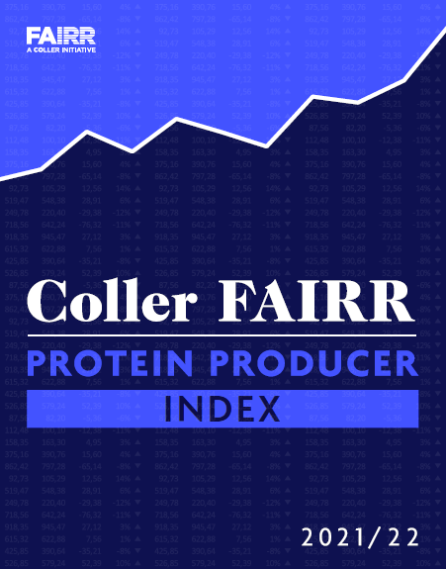Introduction
This report is the fourth edition of the Coller FAIRR Protein Producer Index, which assesses 60 of the largest, listed global meat, dairy and aquaculture companies on 10 environmental, social and governance themes aligned with the Sustainable Development Goals (SDGs). The Index is designed to provide financial institutions with best-in-class data, analytics and trends on the protein sector to integrate into their investment decisions and engagement strategies.
We conduct company assessments using publicly available information. This includes annual and sustainability reports, company websites and (where available) CDP disclosures. The final company rankings are based on two individual scores:
Risk Factor Score: A simple average of scores across the nine risk factors (GHG Emissions; Deforestation & Biodiversity; Water Use & Scarcity; Waste & Pollution; Antibiotics; Animal Welfare; Working Conditions; Food Safety; Governance). Where relevant, company scores on individual risk factors can decrease if policies and programmes are only applicable to certain geographies. On its own, the Risk Factor Score is a useful measure of company performance across the nine risks.
Opportunity Score: This captures the company’s performance on the opportunity factor of Sustainable Proteins.
The Risk + Opportunity Score (overall score) gives more weight to the Opportunity Factor Score versus the Risk Factor Score. This is because growing exposure to alternative non-animal proteins automatically reduces the company’s exposure to these risks.
Results Overview
The fourth iteration of the Index shows that the vast majority of animal protein companies have yet to meaningfully address basic sustainability risks. Of the 60 companies covered by the Index, half rank as ‘High Risk’, on average, across all 10 risk and opportunity factors.
However, there are pockets of good news: the majority of companies (87%) improved their score compared to 2020, with just 10 companies seeing almost no change in score or a lower score than the previous year. Companies have, on average, improved on every risk and opportunity factor assessed compared to 2020.

